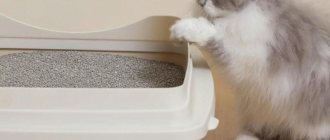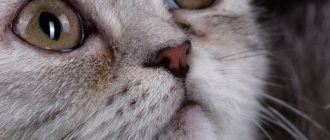(Be the first to vote!)
5589564
08/06/2021 owner reviews
Your new kitten is playful and sweet, except that he eats little or nothing. Kittens consume a lot of energy and should not go long without food.
If your kitten isn't eating solid food, it could simply be because he's not fully weaned yet, or it could be an issue with the type of food. He may also be sick or depressed.
If you find that he is depressed because he has less energy and more sleep than usual, has lost interest in his usual activities or is exhibiting aggressive behavior, spend more time with him, let him play and show him more love. Most often, kittens become depressed because they are not given enough attention.
In any case, do not let them fast for more than 24 hours. If you find that he is not eating at all, he should be taken to the vet. However, you can make some attempts to whet his appetite.
- Don't change his food
- The more it smells, the better
- Try decorating the food
- Hot lunch
- Feed the kitten by hand or syringe
- What to avoid
- Health care
Don't change his food
If your kitten has been eating solid food regularly in his family home, find out the brand and try giving it to him. If the kitten is not accustomed to a variety of foods while with its mother, it will likely be reluctant to try new things, especially after moving to a new home. Bring him some food that he is used to and see if he can eat it.
© shutterstock
Let's summarize: what to do if the kitten does not eat or drink
First of all, you need to carefully observe the animal. If there are no other alarming symptoms, you can try changing the food, bowl, and minimizing stressful situations.
But if the baby’s condition causes concern, and the owner cannot figure it out on his own, there is no need to waste time asking questions on various forums. You need to immediately take the animal to the veterinarian or invite a doctor home. An in-person examination and tests will help identify the exact cause of the ailment and prescribe treatment in a timely manner. If the fears are not confirmed, a professional doctor will give recommendations on proper nutrition. And just making sure your pet is healthy is never a bad idea.
Useful links:
Hot lunch
Sometimes you will be able to persuade him to eat by serving him a hot dinner. If it's canned, try putting it in the microwave until it's warm (a few seconds should do it). On the other hand, if you're feeding him kibble, try mixing it with hot water so it warms and softens at the same time: sometimes the problem can be the hardness of the dry kibble. Some kittens may have been weaned too early or may simply have difficulty chewing dry food. In these cases, softening the food or even completely soaking it and grinding it into a paste will make it easier to eat.
© shutterstock
How to behave better?
When you bring your cat home in a carrier or box, you don’t need to take it out yourself. It is best to place the carrier on the floor and open the door. By their nature, cats are very curious animals; he will definitely come out in the near future and begin to gradually explore his whereabouts. The baby will explore all the nooks and crannies that are sometimes out of reach of the owner and may fall asleep there. That is, if a kitten gets lost in the house in the first days, there is no need to panic and noisily search for it. These actions will make the kitten even more frightened and hide in a corner.
As a rule, on this day the kitten eats little; this is related to the stress that the baby experiences. Don’t be alarmed about this, 2-3 days will pass and everything will return to normal. It’s better to sit down with a bowl of food more often, talk to him kindly, and caress him. In the first days of the kitten’s arrival in the house, you need to feed it the same food as in the old home, this way it will be easier for him to adapt to the new place. Then you can gradually include new food in your diet. It would be nice to create conditions for the baby to have fun, receive positive emotions, and stop being afraid.
Feed the kitten by hand or syringe
Try hand feeding by placing a small amount of food on your finger and bringing it to your kitten's mouth. Try not to put your finger in his mouth as this may irritate him, but let him lick the food at his own pace and be patient. If finger feeding doesn't work, try a syringe. Gently holding the kitten, insert the syringe into the mouth at an angle. Do not insert it directly into his mouth as this will cause the food to go straight down his throat and could choke him. Fold the kitten to the right or left and squeeze a small amount of food onto the back of the tongue. Repeat the process several times until you feel your kitten has eaten enough.
Nausea, vomiting and intestinal obstruction
Contents Nausea and vomiting
How to rationally choose an antiemetic drug?
Intestinal obstruction
Surgery
Nausea, vomiting and intestinal obstruction are painful symptoms that often bother patients in the terminal stage of the disease. We are publishing an excerpt from the book by British doctor Bruce Cleminson, “Introduction to Palliative Care,” about how to relieve these symptoms. The full version of the book is available here.
Nausea and vomiting
It occurs in 50% of terminally ill patients and has four main causes: 1. Gastrostasis and intestinal obstruction. 2. Intoxication. 3. Stretching or irritation of organs. 4. Increased intracranial pressure.
All of these conditions have different causes and different treatments.
Gastrostasis and intestinal obstruction can be caused by:
- medications such as anticholinergics;
- autonomic disorders (nerve infiltration, diabetes);
- ascites;
- hepatomegaly;
- tumor germination;
- peptic ulcer or irritation.
Symptoms:
- discomfort in the epigastrium;
- loss of appetite;
- feeling better after vomiting; quick satiety during meals;
- symptoms occur when body position changes;
- associated belching and hiccups.
Intoxication:
- medications: antibiotics, opioids, digoxin, anti-inflammatory drugs, antispasmodic drugs;
- metabolic products (renal failure, liver failure, ketoacidosis, hypercalcemia, hyponatremia);
- toxins.
Symptoms:
- constant nausea;
- incessant vomiting;
- various signs of drug intoxication.
Introduction to Palliative Care Basic information about the key aspects of palliative care Bruce Cleminson
About palliative care
Organ stretching or irritation:
- liver metastases;
- ureteral obstruction;
- retroperitoneal lymph nodes (tumor);
- constipation;
- intestinal obstruction.
Symptoms:
- constant nausea
- vomiting is not very common;
- frequent accompanying pain;
- other symptoms.
Increased intracranial pressure or meningismus:
- intracranial tumor;
- cerebral edema; intracranial bleeding;
- meningeal tumor infiltration;
- metastases to the bones of the skull; cerebral infection.
Thus, to understand the mechanisms, you need:
- carefully study the medical history;
- conduct a thorough inspection;
- carry out the necessary examinations;
- if possible, eliminate (cure) the cause;
- try any appropriate non-drug treatment;
- rationally approach the choice of antiemetic drug.
How to rationally choose an antiemetic drug?
To make a rational choice, you will need to understand which receptors are involved in the vomiting mechanism. Three zones are involved: 1. Chemoreceptor trigger zone (CTZ). Its other name is “posteriormost field” and is located in the brain. Blood vessels in CTZ have fenestrated epithelium. Fenestrated epithelium (from the Latin fenestra - window) are “windows” in the walls of blood vessels in the epithelial lining, so that chemicals in the blood come into close contact with CTZ cells.
Receptors in CTZ are effective drugs:
- dopamine receptors (D2) - haloperidol;
- 5-HT3 receptors - ondansetron. They cause persistent nausea in response to medications, toxins, and organ failure.
2. Vomiting center:
- H1-histamine receptors - cyclizine or other antihistamines;
- acetylcholine receptors - cyclizine or other antihistamines;
- 5-HT2 receptors - methotrimeprazine.
Opioid receptors
Nausea and vomiting as a result of intestinal obstruction, pharyngeal irritation, liver enlargement, gastric compression and emotional reactions all pass through the vomiting center.
3. Gastrointestinal tract:
- 5-HT → achromatopsia → vagus nerve - cyclizine or other antihistamines;
- 5-HT3 - cilancetron;
- 5-HT4 prokinetic - metoclopramide;
- D2-antikinetic - metoclopramide;
- H2 - ranitidine (or pyrophosphates).
Thus, you need to remember three main drugs:
1) haloperidol - phenothiazine - for CTZ - chemicals - drugs - toxins; 2) cyclizine or other antihistamines - for the vomiting center - feelings - fears - sensations; 3) metoclopramide - gastric prokinetic - with delayed gastric emptying.
And four other drugs you may want to remember:
1) dexamethasone - a steroid - for increased intracranial pressure; 2) hyoscine butyl bromide - an anticholinergic agent (buscopan) to reduce gastrointestinal motility; 3) octreotide - to reduce gastrointestinal secretion; 4) ondansetron - a 5-HT3 antagonist - for nausea associated with chemotherapy.
Intestinal obstruction
Intestinal obstruction is a common occurrence in cancer patients at an advanced stage of the disease. It occurs in 3% of all hospice patients and 40% of patients with ovarian or pelvic tumors.
Establishing diagnosis
It is worth thinking about intestinal obstruction if there is a history of intestinal colic, nausea and vomiting, lack of peristalsis and intestinal bloating in various areas, depending on the level of obstruction.
Nutritional support and rehydration therapy in adult patients Clinical guidelines 2022 Editorial
Main reasons
1. Cancerous tumor:
- compression or germination of the intestinal lumen by a tumor.
2. Reasons not related to the tumor:
- constipation or fecal blockage, which is a common problem in declining patients;
- strangulation intestinal obstruction or strangulated hernia.
Examinations:
- palpation of the abdomen and rectal examination;
- Is the tumor palpable? Where? how big?
- Is the full descending colon palpable?
- An abdominal x-ray can be very informative.
Therapy for causes other than cancer
Resolution of constipation or coprostasis by oral administration of softening laxatives such as lactulose, docusate, phenolphthalein or petroleum jelly. In more serious cases, suppositories, enemas, or, if necessary, manual evacuation of stool can be used.
Treatment for other causes not related to cancer
Strangulated intestinal obstruction or strangulated hernia can be resolved surgically or conservatively, depending on the patient's condition.
Treatment for intestinal obstruction directly related to the presence of cancer
To relieve cramping pain and vomiting, we prescribe hyoscine butyl bromide (buscopan) at a dose of 20 mg or atropine 300–600 mcg subcutaneously. When colic, nausea and vomiting are under control, we prescribe buscopan orally 4 times a day. An oral antiemetic such as haloperidol may be needed.
Attempts should be made to restore bowel function with softening laxatives (eg, lactulose, phenolphthalein, docusate, paraffin). The dose of hyoscine butyl bromide (buscopan) should be reduced after 1 to 2 days of use to see if loose stools are passed. If there is still no stool, you need to think about surgery. If surgery is impossible or impractical, we prescribe buscopan orally 4 times a day to relieve cramping pain and haloperidol to relieve nausea.
If buscopan is not available, replace it with parenteral atropine (eg, subcutaneously using a syringe pump).
Surgery
Many patients benefit from palliative surgical treatment, but the mortality rate is 12–33%, and the risk of external intestinal fistula formation is 7–18%. In a significant number of patients, the obstruction does not resolve, while in others it recurs within a short time. Thus, conservative treatment may be the best option, in each case the surgeon should give his opinion and recommendations so that the patient can make the right decision with all the information.
Example 1
A 75-year-old woman was seen by her family doctor. She suffered from ovarian cancer and made an excellent recovery after undergoing platinum-based chemotherapy. About a year before her death, she suddenly developed heavy bleeding from the lower gastrointestinal tract. As it turned out, this was due to the growth of a tumor in the pelvis into the lower intestines. After the next course of chemotherapy, the tumor shrank again and the bleeding stopped. After 6 months, the family doctor was informed that the patient had cramping abdominal pain and intestinal dysfunction.
The examination showed that 10 cm of the sigmoid colon was not functioning due to tumor infiltration. A stent was placed, but this did not restore normal bowel function, possibly because there was another lesion above the stent or because the stent was a little short or did not fully dilate the bowel, 10 cm is a long distance for a stent. A double-barreled ileostomy was performed, which functioned perfectly until the patient's death.
Example 2
Nutrition in the terminal stage, with dementia or in a state of waking coma An excerpt from the book of the doctor Jean Domenico Borasio “On Death. What do we know? What we can do. How can we prepare for it? Gian Domenico Borasio
Symptomatic treatment
The elderly woman was under the care of her general practitioner. She suffered from widespread oncology, and signs of intestinal obstruction began to appear. The family doctor prescribed her an antispasmodic drug (hyoscine butylbromide), initially by injection, with a gradual transition to oral administration to relieve colic and nausea. After oral administration of lactulose, the intestines began to function. Antispasmodic treatment was later discontinued.
A few weeks later the same thing happened again, but the bowels did not work with an increased dose of the emollient laxative. The antispasmodic dose was increased to prevent colic and nausea, and the patient remained on this treatment until death 3 months later. She had a good quality of life and died very calmly, without vomiting or abdominal cramping.
Conclusion
Intestinal obstruction in a patient with terminal cancer can be successfully managed conservatively. Surgery can also be considered, but if the patient does not have much time left, the operation may not provide a positive effect, but only add suffering, pain and difficulty to the patient and his family.
Diagnostics in a veterinary clinic
If you notice any abnormalities in the kitten’s well-being—tummy pain, lacrimation, dry and hot nose—you should immediately contact a specialist at a veterinary clinic.
When diagnosing, the doctor will:
- visual examination of the baby;
- analysis of swabs of discharge from the eyes;
- urine and stool analysis;
- X-ray and ultrasound examination of the gastrointestinal tract.
Based on the results of the examination, a diagnosis is made and treatment is prescribed.











